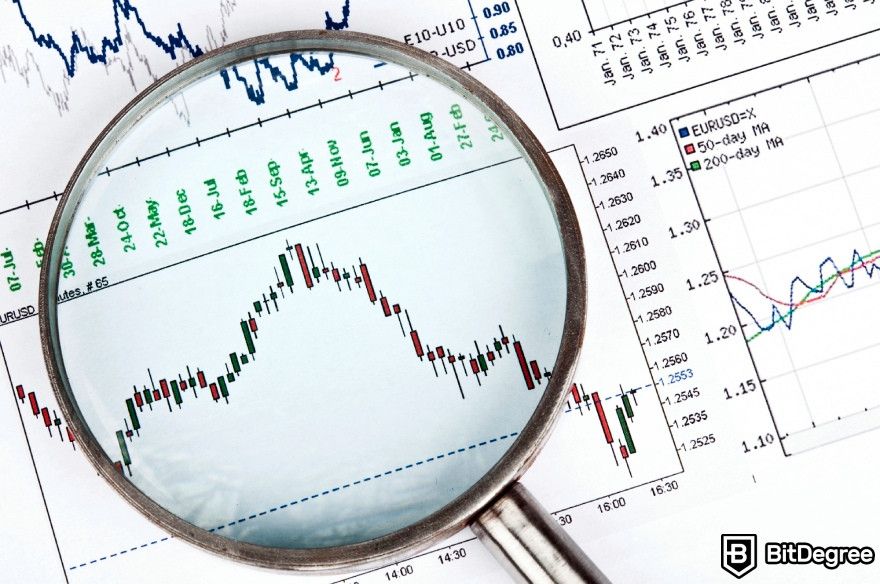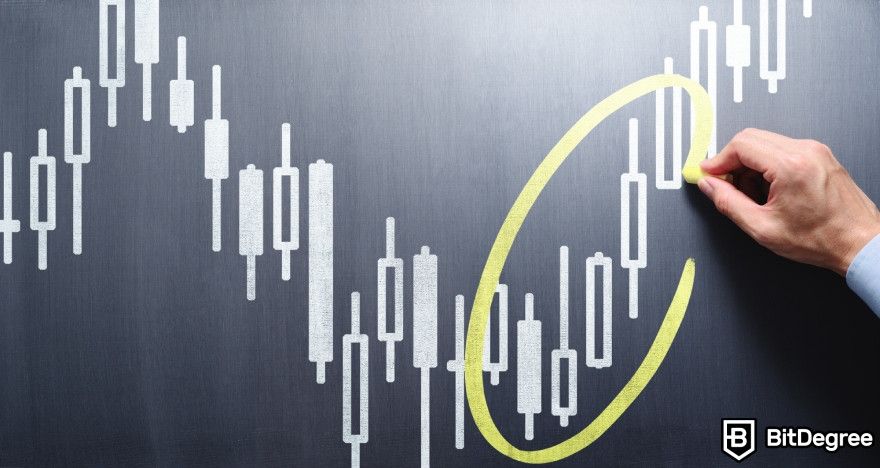Key Takeaways
- The Dow Theory serves as the cornerstone of technical analysis, providing a framework for understanding market trends, price movements, and investor sentiment;
- The Dow Theory emphasizes the interconnectedness of different market sectors and asset classes;
- Despite being formulated over a century ago, Dow Theory's principles remain relevant in today's dynamic financial markets.
Stop overpaying - start transferring money with Ogvio. Sign up, invite friends & grab Rewards now! 🎁
If you wish to truly understand what is Dow Theory, you’ve come to the right place. I will demystify its origins, core principles, and practical implications.
Understanding market dynamics has always been important for traders and investors. Amidst this complexity, the Dow Theory has emerged as a revered cornerstone of technical analysis, providing invaluable insights into stock price movements and market health.
Notably, the Dow Theory's analytical framework has also found resonance in the world of cryptocurrencies. Exchanges like Binance, Bybit, and Kraken witness traders applying the Dow Theory to analyze digital asset price movements and market trends, highlighting its versatility.
So, let’s unveil the secrets of what is the Dow Jones Theory, decoding market dynamics in both traditional stocks and cryptocurrencies.

Did you know?
Subscribe - We publish new crypto explainer videos every week!
Is Decentralized Anonymous Blockchain a Myth? (Explained!)


Table of Contents
What is Dow Theory?
Let's start with the key question – what is Dow Theory? To put it shortly, it is considered one of the oldest and most widely recognized theories in financial markets. Developed in the late 19th century, the theory was conceived by an economist named Charles H. Dow, hence the name.
Latest Deal Active Right Now:First and foremost, the Dow Theory provides a framework for understanding market trends and making informed investment decisions. The theory itself focuses on analyzing small and macro trends of the stock market.
Rather than solely focusing on individual stocks, it emphasizes the importance of studying the collective market direction. The Dow Theory is what suggests that stock markets move in trends, and classifies those trends into primary, secondary, and minor[1].
These trends are influenced by the actions and sentiments of various market participants, including individual investors, institutional investors, and speculators. The primary trend, representing the long-term direction of the market, can span from months to years.
Within the primary trend, there are secondary trends that last for several weeks to several months, reflecting intermediate movements. Additionally, minor trends encompass short-term fluctuations occurring within the secondary trend, lasting only for days or weeks.

Throughout its evolution, the theory has received contributions from notable analysts and undergone heavy transformations[2].
Despite some criticisms of subjectivity and simplicity, the core of what is the Dow Jones Theory remains influential in the field of technical analysis. It serves as a foundation for various other techniques and indicators used by traders and investors.
By applying the principles of the theory, market participants can, ideally, assess market trends, and identify potential reversals or continuations. Investors can use it to make more informed decisions regarding buying or selling real-life assets like securities, or digital assets like cryptocurrencies.
In modern markets, the Dow Theory definition continues to be tested, modulated, and extended. Even for the less enthusiastic crowd, it is part of a movement that wishes to contribute to the understanding of market behavior overall.
This goal is achieved by many means. Assisting market participants in navigating investment decisions is one of its utilities. What the Dow Jones Theory is, after all, is the result of enduring relevance and status as a valuable tool for analyzing and interpreting financial market trends.

As the Dow Theory gained recognition and established its foundations in the early 20th century, its relevance and application evolved over time. A theory like this cannot survive if it doesn’t adapt to the changing market dynamics.
To sum up, the Dow Theory explained the principles behind market movements, acting as a language for interpreting stock market trends.
With a clear Dow Theory definition laid out, we can begin to understand, for example, an intricate relationship between price and volume in market analysis. However, as the financial landscape transformed, an expected evolution became necessary to incorporate new insights and refine its concepts further.
Today, when new investors inquire "What is Dow Theory?" they are faced with an ever-developing term. The concept itself has not remained static since the late 19th century. A theory like this can only work by incorporating innovative strategies and techniques and keeping pace with the complexities that structure modern financial markets.
To catch up on the evolution of what is Dow Theory, let’s explore some key transformation stages that have shaped its significance.
Evolution and Development of the Dow Theory
After discovering what is Dow Theory, we can now dive deeper into the evolution and development that literally shaped and transformed its meaning over time.
Among other things, those transformations were fueled by the natural need to implement refinement and enhancement to its application. Through the contributions of several notable analysts and practitioners, the theory has evolved to incorporate new insights and adapt to changing market dynamics.
One significant milestone in the evolution of the Dow Theory was the work of William Peter Hamilton[3], who succeeded Charles Dow as the editor of The Wall Street Journal. Hamilton expanded on Dow's original ideas and refined some of the theory’s principles.
He introduced the concept of "confirmation". It emphasizes and combines the importance of two indicators that haven’t been linked before. More specifically, it checks if the Dow Jones Industrial Average (DJIA) and the Dow Jones Transportation Average (DJTA) are moving in the same direction.
By the way, DJIA is an index that tracks the performance of 30 large industrial companies in the US, while DJTA represents the performance of transportation-related companies.

Both indexes are used to provide a snapshot of the overall health and performance of the stock market in different sectors. When they align and move similarly, an analyst can validate a specific stock market trend by "confirming" this match.
Now, another influential figure in the development of the Dow Theory was Robert Rhea, who published a book focusing on the theory in 1932. Rhea's work further expanded on Hamilton's ideas, helping solidify what we know today as the core principles of the theory.
He introduced the concept of "phases," which classified market trends into accumulation, public participation, and distribution stages. Rhea's distinctions greatly enhanced the understanding of the psychology behind market movements.
In later years, additional analysts and practitioners such as E. George Schaefer and Richard Russell made their contributions to the Dow Theory’s definition. Schaefer introduced the concept of "divergence," which involves analyzing volume patterns to identify potential trend reversals.

In the grand scheme of things, Russell emphasized the importance of analyzing market averages in relation to other market indicators. With the advent of technology and the rise of computerized trading, tools can reliably reveal average prices and volumes in the chosen date ranges.
More recently, technical analysis software, as well as algorithmic trading have enabled traders to enter and exit markets with greater precision and efficiency. So, the theory continues to evolve to this day, as practitioners and researchers explore new ways to apply it in the context of modern financial markets.
Now that we explored the evolution and development of the Dow Theory, it's time to turn our attention to the main principles that form the foundation of this approach to market analysis.
The Dow Theory and Technical Crypto Analysis
Let's delve deeper into what is Dow Theory’s relevance to analyzing the cryptocurrency market and its key principles. The Dow Theory definition already provides, by itself, valuable insights into market behavior, effectively assisting investors and traders in making their investment decisions. However, there are six key points that drive the whole theory.
The Six Tenets of the Dow Theory
The six tenets of the Dow Theory are considered the bread and butter of any investor or trader. No matter if you are a veteran or an inexperienced trader, they can be invaluable and fundamental. You'll notice that I've already touched upon them a bit in the "What is Dow Theory?" chapter.
1. The Market Discounts Everything
According to what the Dow Theory explained, all known information, including past, present, and future events, is reflected in the price of an asset. Therefore, changes in price reflect shifts in supply and demand driven by new information.
In the crypto market, this means that all available information, including news, developments, and investor sentiment, is already reflected in the price of a cryptocurrency.
2. The Market Moves in Trends
According to the Dow Theory, markets move in three trends: primary, secondary, and minor.
The primary trend represents the long-term direction of a market. It can last for several months to several years and is considered the most important trend to analyze. The Dow Theory suggests that investors should align their investment decisions with the primary trend to increase the probability of success.
Crypto markets can be specifically tricky, as there is the discussion around bear and bull markets, as well as crypto winters. This last one can be compared to a recession to crypto, but it still has its own moving parts. Therefore, the duration of primary trends in the crypto market might differ from those in the stock market.

Within the primary trend, secondary trends, in the form of price movements, most likely occur. Many of them can even work against the primary trend. These trends typically last from a few weeks to a few months, providing opportunities for investors to enter or exit positions safely, in line with the primary trend.
Lastly, the minor trends usually last a few days to a few weeks and are often considered to be "market noise".
3. Trends Have Three Phases
Let's take the crypto market. Initially, there's the phase of accumulation/distribution, where significant players, often referred to as "smart money," start accumulating or distributing a particular cryptocurrency. This phase is marked by sideways price movements and relatively low trading volume.
Following that, the trend transitions into a public participation phase, characterized by clear and sustained price movements in the direction of the prevailing trend. In uptrends, prices steadily ascend, while downtrends witness a continuous decline.
During this phase, trading volume typically increases as momentum traders and trend followers enter the market to capitalize on the directional movement.

Finally, there's the phase of reversal/correction, indicating a potential shift in the prevailing trend. In uptrends, this phase may initiate with a consolidation period or sideways price action as buyers take profits and sellers enter the market. In downtrends, on the other hand, a reversal phase might come with a temporary bounce or relief rally as oversold conditions attract bargain hunters.
Traders closely monitor price action and critical support/resistance levels during this phase to anticipate potential trend reversals or continuations.
4. Indices Must Confirm Each Other
It reflects what is Dow Theory’s major contribution: the importance of multiple indicators confirming each other to confirm the trend. Dow used DJIA and DJTA indices in the theory. For a trend to be considered valid, both averages should move in the same direction.
This principle easily applies to the cryptocurrency market by highlighting the significance of aligning multiple indicators in order to safely confirm a trend. The divergence between indicators may indicate potential weakness or reversal in the trend.
5. Volume Must Confirm the Trend
Volume plays a crucial role in the Dow Theory, whether applying it to security assets or digital ones.

Increasing volume during an uptrend is seen as a confirmation of bullish sentiment while decreasing volume during a downtrend suggests waning selling pressure. Additionally, volume analysis provides insights into the strengths or weaknesses of a given trend. This ultimately leads us to a discussion about continuation vs reversal.
6. Trends Persist Until Reversal
The Dow Theory poses a suggestion around trends. It says that trends tend to persist until there is evidence of a reversal. It’s like the law concept of “innocent until it is proven guilty”. A trend is assumed to be in force until proven otherwise.
Moreover, reversals are indicated by the violation of previous significant highs or lows. Thus, having a theory that names and recognizes them is essential for identifying potential changes in market direction.

- Secure and reliable
- Accepts fiat currencies
- Lots of trading options
- Reputable exchange
- Accepts fiat currencies
- Offers various trading options

- Huge trading variety
- Regulation-compliant around the globe
- Fair trading fees
- Beginner-friendly
- A wide array of features
- Vast number of different crypto coins & tokens

- Beginner-friendly
- Secure
- Decent trading and withdrawal fees
- Crypto.com Visa Card
- Automated tools & bots
- Ecosystem synergy with CRO
Key Elements of Technical Analysis
Okay, now that you understand what is Dow Theory and its six tenets, let’s discuss technical analysis and the key terms you should know (imagine that the crypto market is a river):
- Support and Resistance levels are like sturdy pillars or barriers in a river. They represent specific price levels at which the cryptocurrency tends to find buying support or encounter selling pressure. Identifying these levels helps traders determine potential entry or exit points and gauge the strength of the trend.
- Trendlines are like the banks of a river, guiding the flow of the cryptocurrency's price movements. They are drawn by connecting higher lows in an uptrend or lower highs in a downtrend. Trendline analysis helps traders visualize the trajectory of the trend and identify potential trend reversals or breakouts.
- Retracement levels are similar to eddies or temporary counter-currents in a river. During a strong trend, price pullbacks or retracements occur. Fibonacci retracement levels, for example, are often used to identify potential support levels where the price might bounce back before continuing in the direction of the primary trend.
- Moving Averages can be compared to floating buoys in a river that smooth out the price data and provide a sense of direction. They are calculated by averaging the closing prices over a specific period. Moving averages help identify the overall trend and potential support or resistance levels.

- Chart patterns in crypto analysis are like recognizable formations or shapes that resemble features in a river landscape. Patterns such as triangles, flags, and head and shoulders can provide insights into the future price movements of a cryptocurrency. Traders use these patterns to anticipate trend continuation or reversal.
- Divergence occurs when the price of a cryptocurrency moves in the opposite direction of a technical indicator, indicating a potential shift in the trend. It can be compared to a river splitting into multiple streams. Divergence analysis helps traders identify potential trend reversals or loss of momentum.
- Breakouts are like a river bursting through its banks, meaning something like a significant shift in price action. A breakout occurs when the price of a cryptocurrency breaks above a resistance level or below a support level. Traders often interpret breakouts as a signal for potential trend continuation or the start of a new trend.
By understanding and applying the aforementioned main principles, in addition to the right indicators, investors and traders gain an advantage in analyzing crypto market trends. This reflects how a proper understanding of the Dow Theory can yield advantages in the crypto world. Such analysis is invaluable if one wishes to make more reliable decisions regarding investment strategies, in fiat or crypto positions.
After examining the main principles that make the soul of what is Dow Theory, let's shift our focus to the limitations and criticisms associated with this approach to market analysis. As always, it adds to the discussion and enhances the overall status of what is, ideally, an unbiased approach to a heated topic like this one.
Limitations and Criticisms of the Dow Theory
While the essence of what is Dow Theory has been influential and widely followed throughout the years, it is not without its limitations and criticisms. Understanding these concerns can provide a more comprehensive perspective on the theory's applicability and potential drawbacks.
Let's explore some of the key points that are found when researching limitations and criticisms of the Dow Theory:
Subjectivity and Interpretation
Like any technical analysis approach, a theory that has this shape relies on the interpretation of price patterns and trends.
There is a subjectivity to this, that can lead to different interpretations among analysts. If the same method is applied and it keeps yielding different information, this may result in varying conclusions and predictions.
Lack of Specific Entry and Exit Signals
The theory primarily focuses on identifying the primary trend and secondary reactions. However, it does not provide specific entry and exit signals for trades.

Determining precise entry and exit points may require additional expertise, tools, and analysis beyond the scope of what a static theory can provide.
Limited Application to Non-Stock Markets
The Dow Theory was originally developed for analyzing stock markets and their indicators, particularly the Dow Jones Industrial Average and the Dow Jones Transportation Average.
For this reason, principles taken from this context may not be as directly applicable to other financial markets. Commodities, fiat currencies, or cryptocurrencies all have their own unique dynamics, evoking more tailored approaches.
Limited Consideration of Fundamental Analysis
The theory primarily relies on price and volume analysis, without explicitly incorporating factors such as company financials or macroeconomic indicators.
This limitation may overlook important fundamental principles that can heavily impact market trends and stock prices.
Adaptability to Modern Market Dynamics
Its development happened in an era of different market structures and trading practices. As markets have evolved, with increased automation, high-frequency trading, and complex derivatives, some argue that the theory may not fully account for the intricacies and rapid changes of modern markets.

This can be even more true if we consider crypto since the rhythm and pace of trading are very different from those of its ancestors.
Past Performance vs Future Predictability
Critics argue that Dow Theory's reliance on historical price patterns and trends may not necessarily predict future market movements with certainty.
Historical patterns can be rendered less reliable if we talk about indicators of future performance. When dealing with market tendencies, the snapshot of two identical points in time can freely evolve in different ways. This has to do with overlooked factors or conditions that are hard to track.
By acknowledging these limitations and criticisms, investors and traders can use the core of what is Dow Theory as one tool among many in their market analysis toolkit. Some even argue that the key may be to complement it with other forms of analysis and adapt to changing market dynamics. This may potentially mitigate some of these concerns and add more reliability to decision-making processes.
Having pondered some of the limitations and criticisms, let's now discuss the contemporary relevance and application of this influential market analysis approach. Examining how it is currently used can shed light on its practical value in today's dynamic financial landscape.
Contemporary Relevance and Application
Despite being developed over a century ago, the concept of what is Dow Theory continues to be relevant in modern market analysis. Traders, investors, and analysts utilize its principles and concepts to gain insights into market trends and make informed decisions.
Much can be said about the contemporary relevance and application of this theory. Let’s cover some of the most important points:
Trend Analysis
The core principle of how to start identifying primary trends remains highly applicable today. Traders and investors are still using trend analysis to this day. It can help them understand the long-term direction of markets while aiding in identifying potential opportunities as well as managing risk.
Confirmation Through Multiple Averages
The concept of confirmation, where multiple market averages move in the same direction, remains significant. More than often, traders opt to use a combination of indices or sector-specific averages to validate trends. Combining multiple signals is also a way to enhance their confidence in a previously spotted market signal.
Volume Analysis
Volume remains a key aspect of Dow Theory's relevance in modern markets. First, traders tend to analyze volumes in order to assess the strength of price movements and confirm the validity of trends.

Additionally, volume analysis helps distinguish between significant price movements (supported by high trading activity) and those accompanied by low participation.
Technical Analysis Integration
One can’t deny that Dow's Theory served as a foundation for a number of technical analysis methodologies widely used today. As such, traders often combine the Dow Theory principles with other technical indicators, such as moving averages, oscillators, and chart patterns.
By tinkering with a combination of untested signals, one can try and develop a comprehensive trading strategy. This can be seen as another result of the “confirmation” principle: like a concoction, a trader must mix, test and evaluate the results, and different tools and add yet another layer to this dynamic.
Behavioral Finance Considerations
The theory tries to consider market psychology and investor sentiment, aligning with the principles of behavioral finance. To consider how emotional biases and crowd behavior can influence market trends, many traders and analysts use the Dow Theory as a framework to navigate these factors.
Algorithmic Trading
Dow Theory's principles have been incorporated into algorithmic trading systems. These systems use automated algorithms to analyze market data, identify trends, and execute trades based on many principles, with the Dow Theory being one among many other technical indicators.

Moreover, this integration enhances the speed and efficiency of testing the resilience of indicators in real-time market environments, whether they are digital assets or real-life commodity evaluations.
Global Market Analysis
While the essence of what is Dow Theory originated in the United States, its principles have been adapted and applied globally. Traders and analysts around the world utilize Dow Theory's concepts to analyze and interpret trends in various stock markets, providing a cross-border perspective.
By leveraging the contemporary relevance of the Dow Theory, market participants can combine its principles with advanced tools, technology, and data analysis techniques to enhance their decision-making processes.
Having all of this in mind, we can put our analytical skills to the test, checking which principles apply to our trading experience, and which ones can reliably enhance it.
Conclusions
Now you are many steps further in understanding what is Dow Theory and how it remains a vital principle in comprehending markets. To this day, traders use its principles to analyze the movement of indicators, old and new, in order to gain valuable insights into market trends and investor sentiment.
The Dow Theory explained three main principles — trends, confirmation, and volume — underscoring the significance of identifying major market trends. Moreover, the theory highlights the need for patience, discipline, and a long-term perspective when approaching the stock market (but the same can be applied in the crypto market when trading on exchanges like Binance, Bybit, or Kraken).
All in all, in the ever-evolving financial landscape, the theory serves as a timeless guide to the enduring principles that underpin the stock market. By incorporating these principles, the Dow Theory explained how traders and investors can start navigating the market with greater confidence.
The content published on this website is not aimed to give any kind of financial, investment, trading, or any other form of advice. BitDegree.org does not endorse or suggest you to buy, sell or hold any kind of cryptocurrency. Before making financial investment decisions, do consult your financial advisor.
Scientific References
1. H.S. Benjamin: 'The Dow Theory of Stock Prices';
2. G.W. Bishop Jr: 'Evolution of the Dow Theory';
3. W. P. Hamilton: 'The Stock Market Barometer: A Study of Its Forecast Value Based on Charles H. Dow's Theory of the Price Movement'.









